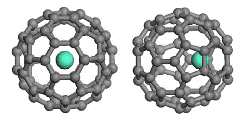Department of Chemistry
Date of this Version
10-1-2006
Abstract
We performed a global-minimum search for low-lying neutral clusters (Aun) in the size range of n=15–19 by means of basin-hopping method coupled with density functional theory calculation. Leading candidates for the lowest-energy clusters are identified, including four for Au15, two for Au16, three for Au17, five for Au18, and one for Au19. For Au15 and Au16 we find that the shell-like flat-cage structures dominate the population of low-lying clusters, while for Au17 and Au18 spherical-like hollow-cage structures dominate the low-lying population. The transition from flat-cage to hollow-cage structure is at Au17 for neutral gold clusters, in contrast to the anion counterparts for which the structural transition is at Au16- [S. Bulusu et al., Proc. Natl. Acad. Sci. U.S.A. 103, 8362 (2006)]. Moreover, the structural transition from hollow-cage to pyramidal structure occurs at Au19. The lowest-energy hollow-cage structure of Au17 (with C2v point-group symmetry) shows distinct stability, either in neutral or in anionic form. The distinct stability of the hollow-cage Au17 calls for the possibility of synthesizing highly stable core/shell bimetallic clusters M@Au17 (M=group I metal elements).


Comments
Published by American Institute of Physics. J. Chem. Physics 125, 154303 2006. ©2006 American Institute of Physics. Permission to use. http://jcp.aip.org/.